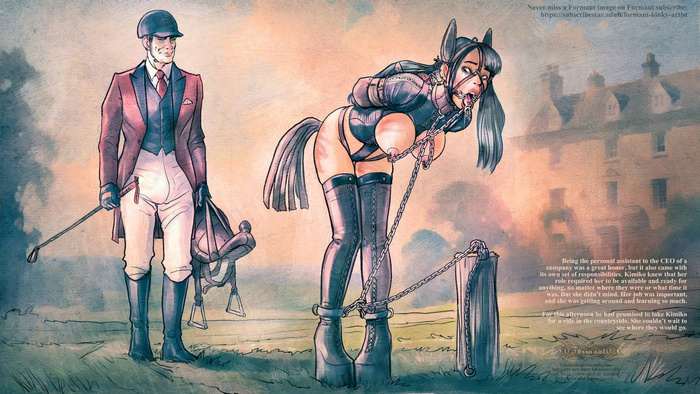Corsetry Back Then and Right Now
articles and tutorials Theory and practice of female domination

The corset, like the shoe, has been an object of fascination and control for centuries, and also has been the source of much controversy. Some attribute the advent of the corset to peoples as ancient as the Minoans on Crete, hundreds of years before the Christian era. Although there is historical evidence that the Minoans did bind their waists for a fashionable and slim look, what they used were strips of cloth with no stays or laces, not corsets as we know them today. We know that the women of ancient Rome and Pompeii used strips of cloth to bind their breasts. In the Middle Ages, clothing became more fitted and differentiated than the loose-fitting garments previously worn by both sexes, and gores, seams, buttons, and laces were employed by tailors and seamstresses alike to produce more shapely garments. These early attempts to show off the womanly figure were not actually corsets but one-piece garments featuring laces up the sides, back, or from to produce a slimming look that often pushed up the breasts as well as cinched the waist.
The corsets we are familiar with today were developed in Renaissance Italy and Spain, when a high priority was put on the fit of clothing. Also at about this time, the elite began to wear not only clothing made of more elaborate materials such as velvet and brocade, but also outfits made of separate pieces: a bodice and a skirt. These more figure-hugging garments demanded the proper undergarments. Much later on, during the Victorian era and at the height of corsetry, the corset got a bad reputation as an instrument of torture and patriarchal control, and even the cause of illness and death. Most of the stories about women having ribs removed, or taking other extreme measures, are myths, with no historical proof whatsoever and little to no basis in reality. Yes, tight lacing could and did do damage to the soft internal organs, but the degree of tightness desired also very much depended on the wearer.
Certainly there were a few women whose waists were an organ-crushingly small 13 or 14 inches, but they were far from the norm, and except in a few situations, we will never know if their participation in extreme tight-lacing was voluntary or enforced. On the other hand, there is historical evidence from a sales brochure that back then a "normal" size corseted waist was considered to be 18 to 30 inches. That doesn't sound so tight to me.
There are two sides to every coin and the corset had, for many, positive connotations. Women from the working class to the aristocracy and everyone in between wore corsets, and for different reasons. Social status, beauty, posture, youthfulness, and respectability were all considerations in the decision to "lace up." If we don’t view ourselves as victims or slaves, or think that corsetting for pleasure is unilaterally foolish, vain, or silly, why should we think that other advocates of the corset thought any differently? By viewing all women who wear or who wore corsets as passive victims of either fashion or male control does women and the corset itself an injustice. Even with the feminist movement, some women not only defended the practice of corsetry but also were major and intimate contributors to their production.
And let's not forget one of the most important reasons of all in the decision to corset up: erotic allure. If women today enjoy admiring themselves in the mirror and running their hands over their corseted figures, why shouldn’t we assume that our sisters in the past enjoyed doing the same? And there is much evidence that their men found a corseted woman to be extremely sexy. Additionally, all corsets were not made to be decorative, fashionable, controlling, or restrictive; some were made for orthopedic reasons like straightening the spine. Orthopedic corsets are still prescribed by today’s doctors.

In our world behind the veil, wearing a corset is a very sensual experience, and a great aspect for couples to enjoy together. The corset is an erotic garment that can be worn by the dominant and the submissive as well as the fetishist, whether female or male. And corsetry is practiced by singles and couples who have little or no interest in any other aspects of BDSM. As a fetishist, I love corsets and waist cinchers, basically any waist-reducing article of clothing, and I love to wear them as accessories. A corset, when worn by the domina, symbolizes and enhances her power and authority, and emphasizes her aloofness, as in “look but don't touch.” Her corset adds to her impenetrable mystery. A corset is a great investment that can be used to enhance your diva or cruel woman persona (see chapter 12, about masochism), and give you more of that figure you always wanted. And a corset can be the ultimate piece of lingerie.
When worn by the domina, the corset is a symbol of her authority; when worn by the submissive at her command, it can be used as a means of control. Corsetting a submissive is a form of bondage employed by the domina to exert tighter (no pun intended) control over him. This same technique can be used as a disciplinary action, or combined for the two. If walking in a corset requires that we move in certain ways to accommodate it, why shouldn’t we assume that he will have the same difficulties? Only in his case, the difficulties will be exaggerated because he doesn't have the years of experience we have. Lots of opportunities for verbal and physical humiliation here, or for corporal punishment. A corset is also a valuable tool for transforming a “he” into a “she.” When used in the latter manner, the corset has the combined effects of disciplining him. satisfying his wish to look like a woman, and relieving his guilt about his cross-dressing fantasies.





